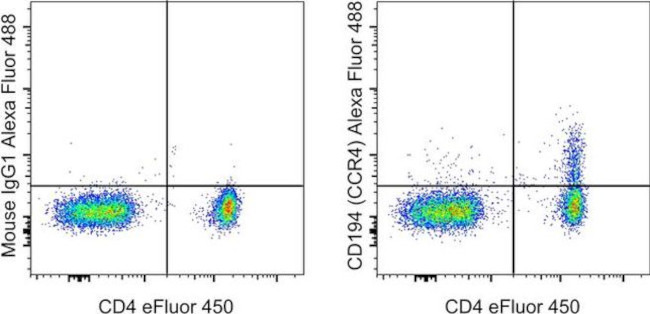Search Thermo Fisher Scientific
Invitrogen
CD194 (CCR4) Monoclonal Antibody (D8SEE), Alexa Fluor™ 488, eBioscience™
FIGURE: 1 / 2
CD194 (CCR4) Antibody (53-1949-42) in Flow


Product Details
53-1949-42
Species Reactivity
Published species
Host/Isotype
Recommended Isotype Control
Class
Type
Clone
Conjugate
Excitation/Emission Max
Form
Concentration
Purification
Storage buffer
Contains
Storage conditions
Shipping conditions
RRID
Product Specific Information
Description: This D8SEE monoclonal antibody reacts with human CD194 (CCR4). CD194, also known as C-C Chemokine Receptor 4 (CCR4) is a member of the G protein-coupled receptor family, a large family characterized by seven transmembrane alpha helical domains. The ligands for CCR4 are CCL17 (TARC) and CCL22 (MDC), which direct the migration of target cells. CCR4 and its ligands, along with the other receptors CCR10 and CLA, are particularly important for the recruitment of T cells into the skin, where they may also play a role in adhesion and extravasation. Although CCR4 expression was originally believed to be restricted to Th2 cells, it has since been observed in some subsets of Th17, Treg, and Th1 cells. It is not expressed by naive T cells, indicating a role in memory or effector function. Other cells that express CCR4 are activated NK cells, platelets, monocytes, and basophils.
Applications Reported: This D8SEE antibody has been reported for use in flow cytometric analysis.
Applications Tested: This D8SEE antibody has been pre-titrated and tested by flow cytometric anaylis of normal human peripheral blood cells. This can be used at 5 µL (0.125 µg) per test. A test is defined as the amount (µg) of antibody that will stain a cell sample in a final volume of 100 µL. Cell number should be determined empirically but can range from 10^5 to 10^8 cells/test.
Excitation: 488 nm; Emission: 519 nm; Laser: Blue Laser
Target Information
CCR4 is a chemokine receptor and is preferentially expressed on type 2 helper T (Th2-type) cells. In contrast to other chemokine receptors, the expression of CCR4 and CCR8 on Th2 cells is transiently increased following TCR and CD28 engagement. Moreover, activated Th1 cells up-regulate CCR4 expression and functional responsiveness to thymus- and activation-regulated chemokine. Chemokines are a group of small (approximately 8 to 14 kD), mostly basic, structurally related molecules that regulate cell trafficking of various types of leukocytes through interactions with a subset of 7-transmembrane, G protein-coupled receptors. Chemokines also play fundamental roles in the development, homeostasis, and function of the immune system, and they have effects on cells of the central nervous system as well as on endothelial cells involved in angiogenesis or angiostasis. Chemokines are divided into 2 major subfamilies, CXC and CC, based on the arrangement of the first 2 of the 4 conserved cysteine residues; the 2 cysteines are separated by a single amino acid in CXC chemokines and are adjacent in CC chemokines.
For Research Use Only. Not for use in diagnostic procedures. Not for resale without express authorization.
How to use the Panel Builder
Watch the video to learn how to use the Invitrogen Flow Cytometry Panel Builder to build your next flow cytometry panel in 5 easy steps.
Bioinformatics
Protein Aliases: C-C chemokine receptor type 4; C-C CKR-4; CCR-4; CD194; chemokine (C-C motif) receptor 4; chemokine (C-C) receptor 4; K5-5; MGC88293
Gene Aliases: CC-CKR-4; CCR4; CD194; ChemR13; CKR4; CMKBR4; HGCN:14099; K5-5
UniProt ID: (Human) P51679
Entrez Gene ID: (Human) 1233

Performance Guarantee
If an Invitrogen™ antibody doesn't perform as described on our website or datasheet,we'll replace the product at no cost to you, or provide you with a credit for a future purchase.*
Learn more
We're here to help
Get expert recommendations for common problems or connect directly with an on staff expert for technical assistance related to applications, equipment and general product use.
Contact tech support

